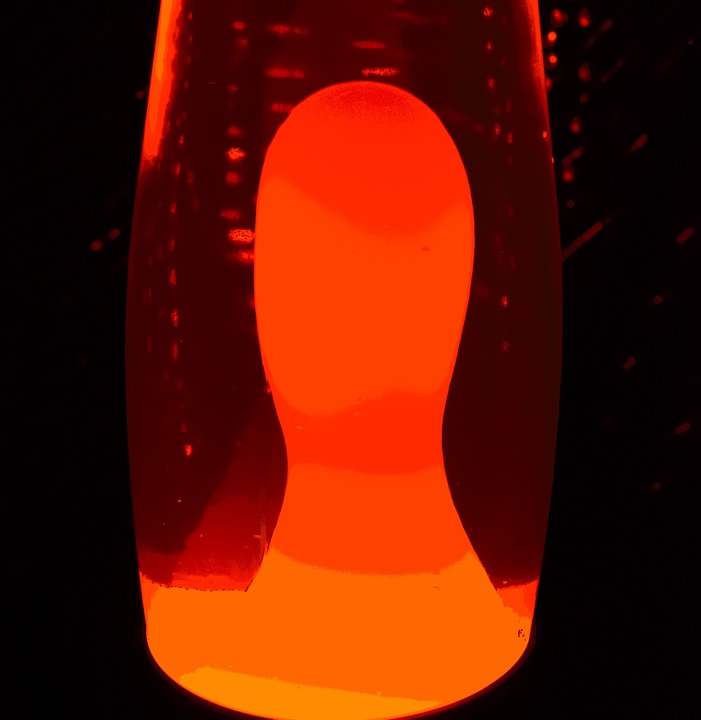A Lava Lamp, also known as Astro Lamp, is a decorative lamp invented in 1963 by the late Edward Craven Walker, a British accountant and businessman. He was the founder of the British lighting company, Mathmos. The lamp is made up of a bolus of a special colored wax mixture in a glass vessel.
Craven-Walker was born in Singapore. During the World War II, he flew an unarmed Mosquito aircraft for photo reconnaissance and surveying missions for the Royal Air Force. He got the idea for the original lamp design when he walked into a pub in Hampshire, England, and noticed an item, which appeared odd, sitting on the counter behind the bar. The item was a glass of cocktail shaker, which contained what seems like mucus blob floating in liquid. Curious to know what it was, he asked the bartender what it was, and the bartender replied that it was an egg-timer. The ‘blob’ was actually a mass of solid wax in transparent liquid.
Do you love retro style? Check out all our retro and vintage style ideas!
Explaining further, the bartender told Craven-Walker that you put the shaker in the boiling water with your egg, and as the water is boiling and cooking the egg, it melts the wax and turns it into an amorphous blob of goo. When the wax floats to the top of the jar, it is an indication that the egg was done.
With the bartender’s explanation, Craven-Walker’s eyes opened to a money-making opportunity. He got an idea to turn the egg-timer into a lamp with a thicker oil that would form sculptural shapes and sell it to the public. He decided to trace the inventor of the original design, a man who is only known today by his last name, Dunnet. He discovered that the inventor had died without patenting his invention. So this led Craven-Walker to patent the product for himself.
Craven-Walker devoted 15 years to perfecting the lamp so that it could be produced commercially. However, he supported himself by making “art-house” films based on his passion, nudity. One of his so-called “art-house” movies, Traveling Light, was the first naturalist film to receive a public release in the United Kingdom. The film, which was described as an underwater ballet, was shot off Corsica and was released in 1960.
Craven-Walker later finished his work on the lamp in 1964 and came up with a cylindrical vase he called the Astro lamp. He introduced the lamp at a novelty convention in Hamburg, West Germany, in 1965. Craven-Walker built a factory in Poole, Dorset where the lamp is still in production till date. He sold the rights to his invention to Mathmos, one of the fastest-growing companies in Britain, and remained as a consultant until he died of cancer at the age of 82.
Lava Lamp in America
During the convention in Hamburg, West Germany, two Americans, Hy Spector and Adolph Wertheimer, saw the Astro lamp and bought the American rights. They renamed it the Lava Brand Motion Lamps Lite and introduced it in the U.S.A just in time for the Psychedelic 60s. The production kicked off in Chicago, Illinois.
In the late 1960s, the sales of Lava Lite peaked as a result of the coincidence between the slow-swirling colored wax and the undulating aesthetics of psychedelia. The lamps were advertised as head trips that offered a ‘motion for every emotion.’
At a time the Lava Lamp was very popular, more than seven million of them were sold around the world every year. However, by the early 1970s, the craze was over and sales dropped significantly. And by 1976, sales fell dramatically to 200 lamps per week. Though sales began to rebound by late 1980s. Then style makers began to ransack the sixties for ideas, and Lava Lambs came back. Previously dollar-a-piece flea-market pickings, original 60s Lava Lamps became real collectibles in the late 1980s. At that time, they were more expensive than a brand new one and not because the new ones were bad for business. By 1998, the sales of the lamp skyrocket again and manufacturers in the U.S. and England sold more than 2 million Lava Lamp in one year.
A Patented Formula
Edward Craven-Walker invented the Lava Lamp in 1963 and his company patented it in 1964. However, the US Patent dates to March 16, 1971. According to an online source, there are conflicting records at the US Patent Office that in 1968, David George Smith submitted the Lava Lamp for a patent on behalf of Craven-Walker’s Crestworth Company under the heading ‘display devices.’ Whatever the case, only the manufacturers of Lava Lamps know exactly what chemicals are in the lamp and in what proportion. The formula remains a trade secret.
Although some websites and books offer layman’s versions of the Lava Lamp that you can make at home. However, we do not recommend attempting any of the formulas contained on such websites or in such books. The reason is that many of the suggested ingredients are flammable and may cause injuries to persons or damage to property.
